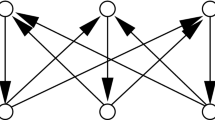Abstract.
In this note, it is shown that by applying ranking procedures to data that allow, for any three objects a1, a2, b in a collection X of objects of interest, to make consistent decisions about which of the two objects a1 or a2 is more similar to b, a family of cluster systems \(\mathcal{A}^{(k)} (k = 0,1, \ldots )\) can be constructed that start with the associated Apresjan Hierarchy and keep growing until, for k = #X−1, the full set \(\mathcal{P}(X)\) of all subsets of X is reached. Various ideas regarding canonical modifications of the similarity values so that these cluster systems contain as many clusters as possible for small values of k (and in particular for k := 0) and/or are rooted at a specific element in X, possible applications, e.g. concerning (i) the comparison of distinct dissimilarity data defined on the same set X or (ii) diversity optimization, and new tasks arising in ranking statistics are also discussed.
Similar content being viewed by others
Author information
Authors and Affiliations
Corresponding author
Additional information
Received November 15, 2003
Rights and permissions
About this article
Cite this article
Devauchelle, C., Dress, A.W.M., Grossmann, A. et al. Constructing Hierarchical Set Systems. Ann. Comb. 8, 441–456 (2005). https://doi.org/10.1007/s00026-004-0231-5
Issue Date:
DOI: https://doi.org/10.1007/s00026-004-0231-5




